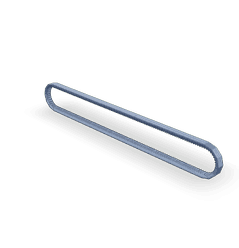This truck part is made by Cummins®. We guarantee that all of our parts are from the OEM (original equipment manufacturer), ensuring a proper fit and quality manufacturing.
We honor the warranty provided by the original equipment manufacturer.
The Cummins 178638 V Belt is a component designed for use in commercial trucks. It serves a significant role in the operation of these vehicles by facilitating the transfer of power from the engine to various auxiliary components. Understanding its function and importance can contribute to better maintenance practices and overall truck performance 3.
Basic Concepts of V Belts
V belts are a type of belt drive that uses a trapezoidal cross-section to transmit power between two pulleys. This design allows for a larger surface area of contact compared to flat belts, which enhances grip and efficiency 4. V belts are commonly used in automotive and industrial applications due to their ability to transmit high power with minimal slippage. They differ from other types of belts, such as timing belts or serpentine belts, in their design and application. V belts are typically used in systems where multiple pulleys need to be driven from a single source, whereas timing belts synchronize the rotation of two shafts and serpentine belts drive multiple accessories with a single, continuous loop 1.
Purpose of the 178638 V Belt
This Cummins part plays a role in the operation of a truck by connecting the engine to components such as the alternator, water pump, and power steering pump. It supports these systems by transferring rotational force from the engine, allowing them to function properly. The efficient operation of these components is vital for the truck’s performance, including electrical power generation, engine cooling, and steering assistance 2.
Key Features
This part is constructed from durable materials that provide resistance to heat, oil, and abrasion. Its length and width are designed to fit specific applications, ensuring optimal performance and longevity. Unique design elements, such as reinforced edges and a specialized rubber compound, enhance its durability and efficiency in demanding truck environments 3.
Benefits
Using this V Belt offers several advantages. Its robust construction contributes to improved durability, allowing it to withstand the rigors of commercial truck operation. The belt’s design enhances efficiency by minimizing power loss during transmission. Additionally, its reliability reduces the likelihood of unexpected failures, contributing to safer and more consistent truck performance 4.
Installation Process
Proper installation of this part involves several steps. First, the engine must be accessed, and the old belt removed. The new belt should be carefully routed according to the manufacturer’s guidelines, ensuring it is properly aligned with all pulleys. Tensioning the belt to the specified levels is crucial for optimal performance. Tools such as wrenches and belt tension gauges may be required, and safety precautions, including disconnecting the battery and using personal protective equipment, should be observed throughout the process 1.
Troubleshooting Common Issues
Common problems associated with V belts include slippage, wear, and noise. Slippage can occur if the belt is not properly tensioned or if it has become glazed from excessive heat. Wear may be indicated by cracks or fraying on the belt’s surface. Noise, such as squealing, can be a sign of misalignment or improper tension. Troubleshooting these issues involves inspecting the belt for signs of damage, ensuring proper tension and alignment, and addressing any underlying problems with the pulleys or driven components 2.
Maintenance Tips
Regular maintenance is key to ensuring the longevity and optimal performance of this Cummins part. Inspection intervals should be established based on the manufacturer’s recommendations or the truck’s operating conditions. During inspections, the belt should be checked for signs of wear, proper tension, and alignment. Replacement guidelines should be followed to ensure the belt is changed before it fails, contributing to the overall reliability of the truck’s engine system 3.
About Cummins
Cummins Inc. is a global power leader that designs, manufactures, and distributes engines, filtration, and power generation products. With a history spanning over a century, Cummins has established a reputation for quality and innovation in the manufacturing of automotive components, particularly for heavy-duty trucks. Their commitment to excellence and customer satisfaction has made them a trusted name in the industry 4.
Conclusion
Understanding the function, features, and maintenance of the Cummins 178638 V Belt is essential for ensuring the efficient and reliable operation of commercial trucks. By adhering to proper installation procedures, addressing common issues promptly, and conducting regular maintenance, truck operators can enhance the performance and longevity of their vehicles.
-
Reif, Konrad Ed. Fundamentals of Automotive and Engine Technology: Standard Drives, Hybrid Drives, Brakes, Safety Systems. Springer Vieweg, 2014.
↩ ↩ -
Williams, Daniel. Generalized Vehicle Dynamics. SAE International, 2022.
↩ ↩ -
Nunney, MJ. Light and Heavy Vehicle Technology, Fourth Edition. Butterworth-Heinemann, 2007.
↩ ↩ ↩ -
Bennett, Sean, and Ian Andrew Norman. Heavy Duty Truck Systems Fifth Edition. Delmar Cengage Learning, 2011.
↩ ↩ ↩
SPECIFICATIONS
RECOMMENDED PARTS
* Variable geometry turbocharger and electronic actuator repairs are not eligible to be claimed as over-the-counter under New or ReCon parts warranty for parts installed after October 1, 2018.
* Diesel Oxidation Catalyst (DOC), Diesel Particulate Filter (DPF), Selective Catalyst Reduction (SCR) catalyst, and Electronic Control Module (ECM) repairs are not eligible to be claimed as over-the-counter under New or ReCon parts warranty for parts installed after January 1, 2020.
* These restrictions are only applicable to New parts and ReCon parts coverages for the components listed above sold to a customer in the US or Canada. All other coverages are excluded. All other regions are excluded.




